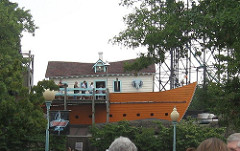
“Who built the Ark?” “Noah! Noah!” “Who built the Ark?” “Brother Noah built the Ark.” This week, in our reading of When Science and Christianity Meet, Janet Browne takes up the topic of The Flood and Noah’s Ark. If you recognize the children’s song I’m quoting, you’ll probably agree with Browne that the Noah story is “deeply embedded” in our minds and culture. Young children respond positively to animals, making Noah’s Ark a natural motif for toys and accessories. My church has a large Ark mural outside the nursery and toddler rooms; I’m sure it’s not the only one. A story so familiar and beloved must be addressed with care.
How many types of animals are there? That’s a deceptively tricky question. At a young age, possibly with the help of one of those Noah’s Ark toys, we learn a dozen or two names for animals: dog, cat, cow, horse, sheep, pig, lion, tiger, bear, etc. Fish and bird were probably part of that vocabulary as well, and perhaps you are already starting to see how that complicates the picture. Dog and cat refer to individual species, while fish and bird cover entire classes of animals. Sure, we can learn to be more specific as we get older, but our common names still don’t always reach the level of species. For example, we talked about finches earlier this year, and finch covers a whole family with hundreds of distinct species. Our intuition may tell us that there are only a few hundred animals if that intuition is based on what we can name, and we can plausibly imagine a boat housing a couple hundred or even a few thousand individuals. But our names are not consistent enough with taxonomy to be reliable.
Our personal experience of learning more about animals and appreciating greater complexity and diversity mirrors the experience of humanity as a whole. Most humans don’t travel far enough and wide enough to encounter more than a few hundred animals different enough to be recognized as distinct. As Browne notes, transportation eventually became sophisticated enough to carry humans from a single civilization to all parts of the globe, and more importantly to bring animals back so that one or a few people could study them all, and in enough detail to sort out their relationships. Eventually we got to tens of thousands of distinct species, and that’s just macroscopic organisms with spines. The discovery that animals were more plentiful, more diverse, and more regionally distinctive than we appreciated made it harder to understand how a historical boat could possibly have contained them all.

 )
)And that’s just the animals we can see. My specialty is infectious diseases, which eventually led me to wonder just how sick everyone and everything on the ark must have been if it had indeed contained all land-dwelling animal life. Pathogenic organisms are frequently specific to particular species, and so the most straightforward way for them to survive the flood would be to tag along with the animals on the ark. Take malaria for example. There are over a hundred known species infecting a range of reptiles, birds, and mammals. Humans have four species of malaria unique to us alone. Were the 8 people on the ark infected with all four in some combination? What about all the other microbial pathogens unique to humans? I’ve not encountered much discussion of this particular facet, but I think it fits in with the overall conversation about how the logistics of the ark could have played out.
My own microscopic perspective leads me in the same direction as many Enlightenment era natural philosophers grappling with taxonomic and geologic evidence. If a global deluge does not fit the evidence, then perhaps the Flood narrative is about a regional event or is meant to convey truth about the kingdom of God but not necessarily the history of Earth. I do recognize that once one heads down that road, it shifts the boundaries around what parts of the Bible to consider history. Thus some prefer to stick with a more traditional interpretation, in part to preserve the interpretation of other passages, and instead focus on finding clever solutions to the practical challenges a literal Ark presents. Given that these questions persist in the present, I’d be curious to hear from you about your perspective.
- How do you think about the Flood story?
- Are there particular facts or details that stand out to you as challenging?
- Do you have a logistical solution that you find satisfying or appealing?
- Do you think we should teach children about the Ark differently to better prepare them for dealing with the complexities of the issue later?
UPDATE – I need to reschedule the planned video chat from 3/14 to 3/21; apologies for any inconvenience.
I hope you can join us at 7:30pm Eastern in two weeks (3/21/2018) to discuss Noah and planaria and everything else face-to-face.
Andy has worn many hats in his life. He knows this is a dreadfully clichéd notion, but since it is also literally true he uses it anyway. Among his current metaphorical hats: husband of one wife, father of two teenagers, reader of science fiction and science fact, enthusiast of contemporary symphonic music, and chief science officer. Previous metaphorical hats include: comp bio postdoc, molecular biology grad student, InterVarsity chapter president (that one came with a literal hat), music store clerk, house painter, and mosquito trapper. Among his more unique literal hats: British bobby, captain’s hats (of varying levels of authenticity) of several specific vessels, a deerstalker from 221B Baker St, and a railroad engineer’s cap. His monthly Science in Review is drawn from his weekly Science Corner posts — Wednesdays, 8am (Eastern) on the Emerging Scholars Network Blog. His book Faith across the Multiverse is available from Hendrickson.

Leave a Reply